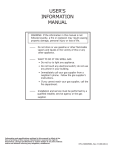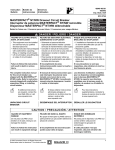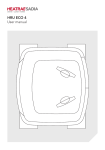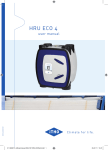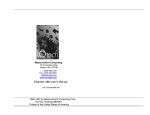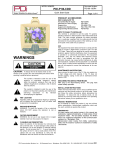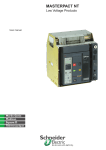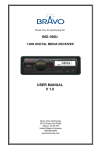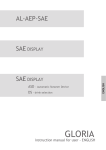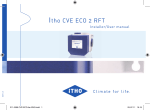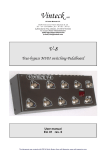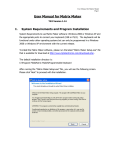Download User Guide - Kair Ventilation
Transcript
Kair VENTILATION LIMITED TM iECO 4 powered by itho User Manual Safety Do not place objects on top of the appliance. Do not use this appliance for functions other than those described in the booklet After removing the appliance from its pa cka ging, ensure t hat it is com plet e a nd undamaged. If in doubt contact Kair Ventilation Ltd. Do not leave the packaging within reach of children or the infirm. Certain fundamental rules must be observed when using any electrical appliance, including a) never touch appliances with wet or damp hands; b) never touch appliances while barefoot; c) do not allow children to use the appliance without supervision; d)supervise infirm persons w hen using t he a pplia nce. Store the appliance out of the reach of children and infirm persons if you decide to disconnect it from the power supply and no longer use it Do not operate the appliance in the presence of inflammable substances or vapours (alcohols, insecticides, petrol, etc). The following general instructions are important: Follow the safety instructions to prevent fan damage and personal injuries. Maintenance instructions must be followed to prevent damage and/or excessive wear and tear. The specifications in this manual may not be modified. The fans may not be modified. The motor module is only suitable for a 230 V 50 Hz a.c system. Do not expose the appliance to the weather (rain, sun, etc). Regularly inspect the appliance for visible defects. If any faults are found, contact Kair Ventilation Ltd. immediately. The appliance must only be installed by a professionally qualified person. Ensure that the electrical system to which the appliance is connected complies with applicable standards. Use a multi-polar switch with a minimum contact gap of 3 mm to install the appliance. Switch of the appliance at the main switch: a) if the appliance does not function correctly; b) before cleaning the outside of the appliance; c) if the appliance is not to be used for any length of time. Be careful to avoid damaging the electric circuit. Do not use the appliance to control activation of water heaters, room heaters etc., nor should it discharge into the flues of any such appliances. Ensure that the appliance discharges into a single duct (dedicated to this product) which is routed to the outside. The air to be extracted from the dwelling must be clean (i.e. free of grease, soot, chem ica l a nd corrosive a gent s, ex plosive or flammable mixtures). Keep the appliance intake and outlet grilles free to ensure optimum airflow at all times. 1 Safety ! The HRU ECO 4 contains parts which may be live. The valves should always be placed back in their Consult a professionally qualified installer in the event of an alleged fault. All repairs and original loca tions. Do not turn the valve during the cleaning process; or make sure to mark the maintenance work should be carried out by a professionally qualified installer. setting before cleaning the valve. If the valves are switched or set differently, the ventilation volumes will no longer be correct and the vent ilat ion syst em w ill not w ork opt im a lly. The The ventilation unit should be inspected regularly for contamination. Electrically discharge the unit before carrying out any work on it. First isolate the unit from the mains supply and make sure that the unit is not re-connected to t he supply plug is not reinser t ed in t he socket by yourself or anyone else before you have completed the work. The HKair RU iECO ECO 4 cont a ins rot at ing m echa nica l par t s. These pa r t s w ill keep on t urning f or a f ew seconds after disconnecting the unit from the supply. For this reason wait at least 10 seconds a f t er isolat ing t he product bef ore opening t he unit. The fan will not be moving after these 10 seconds have elapsed. The valves and grilles in your home should also be cleaned r egularly. These can be removed from the wall or ceiling. Beware of protruding duct sections. These can be very sharp. 2 bathroom may then remain humid for too long, your toilet may be very cool or your kitchen may smell mouldy. Table of Contents 1. Why use balanced ventilation? 2. The correct use of your ventilation system 4 6. System control 9 7. 11 Maintenance 5 8. Warranty conditions 13 6 9. Manufacturer’s statement 15 4. Bypass and frost protection 7 10. EU Declaration of Conformity 16 5. 8 11. Troubleshooting 17 3. Operation of the balanced ventilation system Grilles Subject to changes without notice. No rights can be derived from this user manual. 3 1 Why use balanced ventilation? Ventilation is necessary carpets, parquet, newspapers and cigarettes, In the past people built houses which were not contain substances that harm the health of the residents. All the moisture such as water vapour air-tight, which leaked air, for example, at the connection point of the wall and the floor or roof. Cracks were always visible around windows and doors. All these openings ensured that large volumes of air moved in and out of the buildings. When the wind was blowing the complete air content of the home was refreshed three to four times an hour. This ensured very good ventilation of the home, but a lot of energy was lost. Construction methods have changed. Floors, walls and roofs are, when possible, constructed with a layer of insulation. The insulation ensures that there are nearly no cracks and the airtightness is increased. It is a misconception to think that there is still enough ventilation in a home without some type of ventilation system. Ventilation is absolutely necessary in an air-tight home to prevent problems related to humidity, mould and the health of the residents. Moisture content of the home Incorrect use of the ventilation system by the resident in combination with today’s wellinsulated homes gives humidity an open field. The moisture content in the homes increases and can cause health, humidity and mould problems. A family of four persons produces 14 to 20 litres of moisture per day just by breathing, sleeping, cooking, washing, dishwashing, bathing, watering plants, etc. Many products, such as textile, 4 and aromatic substances should be removed from the homes. The correct use of your ventilation system 2 Ventilation requires energy. The correct use of the 5 to 20% of people have an airway disorder. ventilation system can limit energy loss as much as possible. The number of house dust mite has increased a hundredfold in the past 25 years. Your home has a Kair Ventilation Limited The number of people suffering from Chronic Non-Specific Lung Disease has doubled in the supplied It ho ba la nced vent ilat ion syst em w it h heat recovery. This system can contribute last 15 years. ex t ensively t o a hea lt hy int erior clim at e a nd a n optimum comfort level. Another advantage is Research has proven that fighting moisture in homes greatly contributes to the decrease of that the electricity costs are lower than that of allergic reactions of people with an airway any other ventilation system. The balanced vent ilat ion syst em ca n, how ever, only f unct ion disorder. The correct use a nd m a int ena nce of your balanced ventilation system makes this correctly when used and maintained in a responsible manner. Some data: possible! 5 Operation of the balanced ventilation system 3 saved a s t he heat of t he discha rged a ir is t ra nsferred to the fresh air intake. The air flows through the ventilation ducts to the bedrooms, living room and, if required, the hallway, i.e., every room with an intake grille. The heat exchange is highly efficient. Approximately 95% of the discharged warmth is reused within the home on average. The heat loss is, therefore, only about 5%. The central unit of the balanced ventilation system in y our home is the iECO 4 (heat recovery unit). This unit has two motors. One m ot or f or a ir ex t ra ct ion a nd one f or a ir supply. Air is extracted from the kitchen, bathrooms, en-suites, utility rooms and toilets and, if required, from a storage room. The contaminated air is filtered and fed through the hea t ex cha nger bef ore it is discha rged out side. The fresh outside air is also filtered and fed through the heat exchanger before it is allowed into the home. Two air flows are led alongside each other in the heat exchanger (the air flows are, therefore, not intermingled). Thus, energy is 6 Notwithstanding the heat exchange, which preheats fresh outside air, the balanced ventilation system should not be seen as a heating system. It is a ventilation system that contributes to the comfortable and healthy climate of your home. The installation design assumes there is a 1.5 cm space betw een the bottom of all internal doors outside door and the floor covering. If the floor covering is thicker, the doors should be shortened. Bypass and frost protection 4 4.1 Bypass The kair heat recovery unit iECO 4 is delivered In a balanced ventilation system the volume of as standard with a bypass valve. This valve is completely integrated in the unit and ensures that, air coming from outside equals the amount of air discharged from the home. The outside air suc- if required, the fresh outside air flows directly to the air supply system instead of through the heat t ion f a n, t heref ore, t urns f a st er w hen t he f rost protection is triggered. Thus, the volume of air exchanger. In this case there is no heat transfer between the warmer discharge air from the home coming from outside remains the same as the amount of air discharged from the home. The and the colder intake air that is drawn into the home. The fresh outside air is blown directly into total volume of air intake increases proportionally with the volume of air taken in from the home by the home. This is definitely an advantage in the the frost valve. Opening the frost valve is not summer, when the outside air is often cooler than the air within the home. sufficient when the outside temperature is even lower. The intake fan will turn more slowly and, 4.2 Frost protection The unit includes, as standard, frost protection. This protection ensures that the unit does not freeze during the winter. The frost protection consists of a unique frost valve integrated at the top of the unit. The frost protection is fully automatic. In the heat recovery unit the fresh (colder) outside air is par tly heated by the air discharged from the home. The exchange of heat takes place when both air flows are led through the heat exchanger. The discharged air may be cooled to a temperature very near freezing by the cold air entering the unit from outside. In this case, the unit will regularly open the frost valve and take in warm air from the home. This warm air is mixed with the cold air that is taken in from outside. The temperature of the intake air is, therefore, higher and the discharge air in the heat exchanger will also be safely above freezing. The unit will thus not freeze. after some time, the discharge ventilator will turn faster. The air, therefore, remains above freezing. This result s in a t em pora ry im ba la nce of t he ventilation (the volume of air coming from outside is no longer equal to the amount of air discha rged f rom t he hom e). W hen t he out side temperature increases, the unit automatically resets the fans to the initial values. The ventilation is thus once again balanced. 4.3 Electronic components The electronic components are important parts of the unit. The electronic components control the operation of the unit when you set the mode switch. The motor is set to the speed that ensures the desired ventilation. The electronic components consist of a basic printed circuit board and an optional radio frequency module. This can be used to extend the ventilation unit with radio frequency operation. The user should not touch the electronic com ponent s. These com ponent s m ay be live. 7 5 Grilles 5.1 Grilles Extraction/Intake Grilles grilles The volume of air that has to be extracted is specified in the Building Regulations. The volume of air flowing into the home has to be in balance with the extracted volume. The volume of air extracted from and supplied to the home should, in other words, be equal. The minimum air volume per room is also determined by the Building Regulations. The set volume of air is determined based on achieving an optimum home climate without wasting energy. The air intake and discharge per room are not equal. The extraction and intake grilles all have their own fixed positions and settings. 8 ELF The setting of the grilles should not be changed. Changing the settings may disrupt the operation of the complete ventilation system. Grilles and valves should not be switched with each other. System control 6 The iECO 4 “Combiflow” system has been designed to recover as much heat as possible and to function well using as little energy as possible. The kair iECO 4 can be operated using a radio frequency operation switch. RF operation switch The RF (radio frequency) operation switch The ventilation unit can be switched to high (transmitter) can be used as a 3-position mode switch with timer feature for the iECO 4 mode for a predetermined time by pressing the timer button. vent ilat ion unit . This operat ion sw it ch ca n be used to set the ventilation unit to one of the The timer automatically switches the ventilation unit to low mode after the time has elapsed. three ventilation modes (capacities): The modes are: Mode 1 - Low mode Mode 2 - Medium mode Mode 3 - High mode The low mode is used at night, the medium mode during the day when there are people at home and the high mode when cooking, showering or bathing. The length of time set for the timer is det erm ined by t he user. Press the timer button once to set the ventilation unit to high mode for 10 minutes. Press the timer button twice to set the ventilation unit to high mode for 20 minutes. Press the timer button three times to set the ventilation unit to high mode for 30 minutes. If the operation switch is used by choosing mode 1, 2 or 3 while the timer is in operation, the timer is switched off and the ventilation unit operates in the chosen mode. 9 Recommended hours of operation A new home contains approximately 2000 litres To guarantee a healthy environment in your of moisture in its floors and walls. This moisture has to be removed from the home. It is home we recommend the following daily hours of operation for the ventilation system: At most 14 hours in low mode At least 8 hours in medium mode At least 2 hours in high mode recommendde that a new home be ventilated more intensively during the first few months. For example, by setting the ventilation system to medium mode instead of low mode during the recommended hours of operation provided in the above list. 10 Maintenance 7 The filters Air flow For the user, maintenance is limited to cleaning Valve the filters. In order to safeguard the proper functioning of the unit, the filters will have to be cleaned or replaced regularly. The table below indicates the average terms for maintenance or Grilles The grilles have to be cleaned regularly to ensure the constant and reliable operation of the ventilation system and for your own health. Make sure that the setting of the system (air flow) is not changed when you clean the grilles. The valve could be turned by accident and this would mean that the opening becomes larger or smaller. Each grille should be placed back in the same duct opening in the same room from which it was removed. Filters The heat recovery unit and the extractor have filters. The filters prevent the contamination of the ventilation, guarantee years of correct operation and ensure that clean air is blown into your home. This is very important for your health. Check and clean the filters regularly (a few times a year) and replace the filters when necessary. This ensures the home is ventilated sufficiently at all times. The filters can be cleaned manually by washing them. Cleaning grilles without filters Grilles without filters can be taken out of the duct opening (twist to the left). Before you clean the grille in warm water (with detergent), remove the foam plastic ring. After cleaning, the grille can be replaced in the duct opening with a twist to the left. Always make sure you replace a grille in the same room. replacement of the filters. This may differ per situation. The unit comes with standard G3 filters. Up to half a year after the delivery of the house, the filters will have to be cleaned once a month. After this, the filters will have to be replaced. Filter G3 G4 F7 Clean Every 3 months Every 9 months Every 7 months Replace Once a year Once every 1.5 years Once a year Replace the filters in this order: Take the power cable out of the socket Pull the filter holders out of the unit Remove the old filter from the filter holder Clean the old filter or take the new one from the packaging (filters can be cleaned with a vacuum cleaner) Place the new filter in the filter holder put the power cable back in the socket Insect filter Once a year, the insect filter must be cleaned. The occupant can do this him / herself. First, remove the power cable. Remove the yellow cap at the top of the unit. Now insert the nozzle of the vacuum cleaner into the hole and turn on the vacuum cleaner. This way the vacuum cleaner removes any mosquitoes and suchlike present. Replace the yellow cap and switch the unit on again. 11 If the air trap runs dry, the air from the house sewerage will be able to enter through the unit and be discharged outside by the discharge ventilator. No smell will be caused but the discharge capacity will decrease. We recommend refilling the air trap quarterly. The water will evaporate more quickly in summer. Removing the front of the unit You can order new filter sets for the iECO 4 from Kair Ventilation Limited. When the air trap runs dry, a direct connection with the house sewerage is created. This creates smells. Refill the air trap using the fill opening to solve the problem. Effective discharge of cooking and baking vapours in the kitchen is guaranteed by the extractor. The extractor is connected to the balanced ventilation system. The warm contaminated air passes along the colder f resh out side a ir in t he heat ex cha nger of the heat recovery unit. These air flows are com plet ely sepa rat ed. Condensat ion of t en results. The iECO 4 has a condensation discharge to drain the condensation. This discharge has a PVC coupling with a 40 mm external dia m et er. The inst a ller connect s t his coupling of the heat recovery unit to the house sewerage using a separate removable rubber coupling. An air trap with a minimum level difference of 250 mm is added in this connection. Above the air trap, a branch pipe is mounted at a 45-degree angle. This branch pipe has a cover with a rubber ring. This can be opened to easily top up the water trap. This is required to maintain or restore the water trap. 12 It is preferable to have a registered installer carry out the cleaning. Warranty conditions 8 The Kair iECO 4 warranty is valid for 2 years after production date. The production date is indicated on the type plate. The warranty does not apply to: disassembly and assembly costs faults which are, in our opinion, caused by incorrect treatment, negligence or an accident faults that have been caused by repairs or intended repairs by third parties wKairut our authorisation. faults caused by irregular and / or incompetent maintenance. Should the unit become damaged or malfunction, switch it off, isolating it from the mains supply, and contact Kair Ventilation immediately. 13 9 Warranty card The warranty is only valid if the warranty card was filled in by your supplier on the date of installation and if it is sent along with any request for repair (a receipt including the date of installation is also acceptable). This warranty card should be filled in on the installation date and be kept by the user. Type Serial number Voltage Installation date Supplier seal 14 Energy-efficient climate control systems that add to your comfort. Kair proves it can be done. Wherever you live or work, there’s a good chance that you will come into contact with Kair products and services in the coming months and years in the UK. After all, we develop climate systems for all those places where people are active; from homes to offices; restaurants and hotels. The residents, occupants and owners of all of these buildings ultimately always demand the same two things. On the one hand, they want the highest possible level of comfort. On the other hand, they also want the lowest possible energy consumption. At first glance, these would appear to be conflicting demands. At Kair, we have made it our goal to prove that these two demands can actually go hand in hand. We have the professional skills, drive and innovative strength necessary to actually provide the proof: with statistics, test results and mostly, satisfied and enthusiastic clients and users. Kair VENTILATION LIMITED Kair Ventilation Ltd. 6, Chiltonian Ind Est, Manor Lane, Lee, London, SE12 0TX Tel: 08451 66 22 40 Fax: 08451 66 22 50 E-mail: info kair.co.uk Web: www.kair.co.uk TM
















